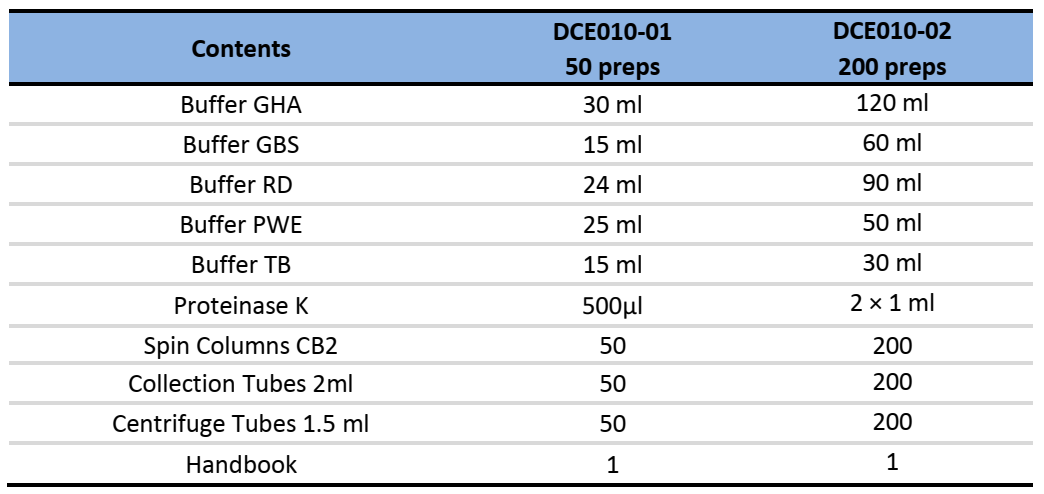The Buccal Swab/Saliva DNA Kit was created specifically for obtaining genomic DNA from buccal swabs, saliva, mouthwash, and other buccal sample types. Within one hour, purified genomic DNA can be obtained from the specimen. The Kit offers high purity and reliable quality DNA free of proteins and other organic compounds thanks to its unique silica-membrane technology and buffer solution. Restriction analysis, PCR analysis, Southern Blot, and library construction can all be done directly with purified DNA. The following kinds of buccal samples are accepted: buccal swab, saliva, mouthwash, and other buccal sample types. The kit should be kept at room temperature (15-25 degrees Celsius).
Storage:
Store at room temperature (15-25℃)
Components:

Specifications:
| Features | Purified genomic DNA can be extracted from buccal swab, saliva, mouthwash and other buccal sample types within one hour. Purified DNA can be used directly for PCR, restriction digestion and Southern Blot. |
| Application | The purified DNA can be used directly for molecular biological experiments such as restriction analysis, PCR analysis, Southern Blot and library construction. |
| Sample type | Buccal swab, saliva, mouthwash and other buccal sample types |
Ensure that ethanol (96-100%) has been added into Buffer RD and Buffer PWE, isopropanol has been added into Buffer GBS as indicated on the tag of the bottle before use.
- Sample preparation:
a. For Buccal swab samples: To collect buccal cells, scrape the inside of the buccal cavity 10 times with a buccal swab. Dispense 500 μl Buffer GHA into a 2 ml microcentrifuge tube. Remove the collection swab from its handle using sterile scissors, and place the detached head in the tube. Add 10 μl Proteinase K, close the lid, and mix by pulse-vortex for 10 s. Incubate at 65°C for 15-30 min. Vortex every 10 min. Pipet 300-350 μl into a new microcentrifuge tube used for the next step.
b. For pharyngeal swab samples: To collect pharyngeal cells, scrape the inside of the pharyngeal 10 times with a pharyngeal swab. Dispense 1-2ml Buffer GHA into a 5 ml microcentrifuge tube. Remove the collection swab from its handle using sterile scissors, and place the detached head in the tube, mix thoroughly by upsides and down. Pipet 300-350 μl into a new microcentrifuge tube, then add 10 μl Proteinase K, close the lid, and mix by pulse-vortex for 10 s. Incubate at 65°C for 30 min. Vortex every 10 min.
c. For fresh saliva samples: Prior to collection of saliva samples, the donor should rinse their mouth with a few milliliters of water for 10 seconds in order to remove any food particles that may be present. Ten minutes after rinsing, collect saliva by spitting into a sterile collection tube or vial (not supplied). The amount of saliva collected should be at least 100 μl but not more than 2 ml. Add equal volume of Buffer GHA, mix thoroughly by upsides and down. Pipet 300-350 μl into a new microcentrifuge tube, then add 10 μl Proteinase K, close the lid, and mix by pulse-vortex for 10 s. Incubate at 65°C for 30 min. Vortex every 10 min. - Add 500 μl Buffer GBS (Ensure isopropanol has been added), and mix thoroughly by upsides and down. Incubate at room temperature for 5 min.
- Pipet the mixture from step 2 into the Spin Column CB2 (in a 2ml collection tube) and centrifuge at 12,000 rpm (~13,400 × g) for 30 s. Discard flow-through and place the spin column into the collection tube.
- Add 500 μl Buffer RD (Ensure ethanol has been added) to Spin Column CB2, and centrifuge at 12,000 rpm (~13,400 × g) for 30 s, then discard the flow-through and place the spin column back to the collection tube.
- Repeat step 4.
- Add 600 μl Buffer PWE (Ensure ethanol has been added) to Spin Column CB2, and centrifuge at 12,000 rpm (~13,400 × g) for 30 s. Discard the flow-through and place the spin column back to the collection tube.
- Repeat step 6.
- Centrifuge at 12,000 rpm (~13,400 × g) for 2 min to dry the membrane completely. Open lid of CB2 and stay at room temperature for a while to dry the membrane completely.
- Place the Spin Column CB2 in a new clean 1.5 ml microcentrifuge tube, and pipet 50 μl Buffer TE or distilled water directly to the center of the membrane. Incubate at room temperature (15-25°C) for 2-5 min, and then centrifuge for 2 min at 12,000 rpm (~13,400 × g).
- The purified genomic DNA can be stored at 2-8°C for a few days. For longer term storage, -20°C is recommended.



